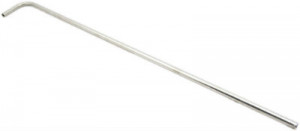-
Tri Clamp Compatible Fittings
- Tri Clamp Compatible X NPT Adapters
- Tri Clamp Compatible X Hose Barb Adapters
- Tri Clamp Compatible X Cam & Groove Adapters
- Tri Clamp Compatible X Quick Disconnect Adapters
- Tri Clamp Compatible X Beer Thread Adapters
- Tri Clamp Compatible X Garden Hose Thread adapters
- Tri Clamp Compatible X Corny Post Thread Adapter
- Tri Clamp Compatible X Compression Adapters
- Tri Clamp Compatible X Flare Adapters
- Tri Clamp Compatible X BSP Adapters
- Tri Clamp Compatible Clamps
- Tri Clamp Compatible Gaskets
- Tri Clamp Compatible Valves
- Tri Clamp Compatible Ferrules
- Tri Clamp Compatible Caps
- Tri Clamp Compatible Elbows
- Tri Clamp Compatible Tees
- Tri Clamp Compatible Wyes
- Tri Clamp Compatible Crosses
- Tri Clamp Compatible Sight Glasses
- Tri Camp Compatible Concentric Reducers
- Tri Clamp Compatible Eccentric Reducers
- Tri Clamp Compatible Cap-Style Reducers
- Tri Clamp Compatible Spools
- Tri Clamp Compatible Check Valves
- Tri Clamp Compatible PRV Tank Breathers
- Tri Clamp Compatible Pressure Gauges
-
Shop By Size
- 1/2"-3/4" Tri Clamp Compatible Fittings
- 1"/1.5" Tri Clamp Compatible Fittings
- 2" Tri Clamp Compatible Fittings
- 2.5" Tri Clamp Compatible Fittings
- 3" Tri Clamp Compatible Fittings
- 4" Tri Clover Compatible Fittings
- 6" Tri Clover Compatible Fittings
- 8" Tri Clover Compatible Fittings
- 10" Tri Clover Compatible Fittings
- 12" Tri Clover Compatible Fittings
- Brewery Controllers
- Brew Stands & Systems
- Brewing Kettles & Hop Filters
- Burners & Accessories
- Cam & Groove Fittings
- Carbonation Stones
- Conicals & Accessories
- CIP Spray Balls
- Custom Welding
- Fermentor Kits
-
Gaskets
- 1/2" & 3/4" Tri Clamp Compatible Gaskets
- 1"/1.5" Tri Clamp Compatible Gaskets
- 2" Tri Clamp Compatible Gaskets
- 2.5" Tri Clamp Compatible Gaskets
- 3" Tri Clamp Compatible Gaskets
- 4" Tri Clamp Compatible Gaskets
- 6" Tri Clamp Compatible Gaskets
- 8" Tri Clamp Compatible Gaskets
- 10" Tri Clamp Compatible Gaskets
- 12" Tri Clamp Compatible Gaskets
- Kegging Equipment/Accessories
- Modular Return System
- O-Rings
- Pumps
- Quick Disconnect Fittings
- RIMS Tubes & Electric Brewing
- Thermowells
- Stainless Tubing
- Threaded Fittings
- Temperature Probe Components
- Temperature Sensors
- Wort Strainers
- Tubing/Hose
- Weldless Fittings
- Merch
- Clearance
- Anvil Brewing
- Blichmann Engineering
- Five Star Chemicals
- Penguin Chillers
- Tapcooler Bottle Filler & Accessories
Sanke Keg Fermentor Kits
Stainless steel is the best option for fermentation. It's impervious to oxygen and light. It's also much safer than glass. (search any home brewing forum for "carboy" and read the horror stories about broken carboys!) Unfortunately it's also very expensive. Conical fermentors are the best of the best option, but also out of reach of the typical home brewer with starting price tags well over $400. The problem is also compounded if you're home brewing 10 gallon batches since most carboys and other fermentors are limited to about 5 gallons.
So what's a homebrewer to do?
It turns out, a Sanke Keg makes a great fermentor! You don't even have to cut it up or try to fabricate some crazy lid that'll never quite seal right. Like everything home brewing related, there are as many solutions to using a Sanke Keg as a fermentor as there are brewers. The low-budget method is to heat up a 6.5 gallon carboy cap and stretch it over the opening. Add a stainless steel racking cane and a blow-off hose and you're good to go.
A More Elegant Solution:
The carboy cap method of converting a Sanke Keg to a fermentor is effective and cheap, but if you're looking for something a little more elegant, a little cleaner and longer lasting, then our stainless steel Sanke Keg Fermentor Conversion Kit is the answer. Made from all stainless steel, it starts with a 2" sanitary Tri-Clover cap. A 3/8" compression fitting is machined and then welded into the cap. This allows the user to position a Linear Racking Arm as needed for sediment free transfers and for collecting yeast. finally a polished stainless steel thermowell and a 1/2" blow-off port are welded into place.
Features:
- All Stainless Steel Construction.
- Fits American-Style Commercial Sanke Kegs.
- TIG Welded for a life-time of service - No End-User Welding Required!
- 3/8" Polished Linear Racking Arm for Sediment Free Transfers.
- .29" ID Polished Thermowell For Accurate Temperature Monitoring and Control.
- Built-in 1/2" Blow-Off Port
- American Sanke Keg NOT included.
Fermenter vs. Fermentor; what's the difference?
For years now, we have seen both terms used interchangeably on web sites and forums. In order to be technically accurate, we did a little research to find out the difference between a fermentor and a fermenter. It turns out that a fermenter is an organism that causes or performs fermentation, in the case of brewing, this is the yeast. A fermentor is the container or apparatus in which fermentation occurs. So your new fermenter is actually a fermentor and yeast is the fermenter! Does that make your wort the fermentee? I think this requires some more research.
A Note About Legal Sanke Kegs:
The best place to find a Sanke Keg is at a recycling or scrap yard or a brewery. Sanke Kegs are the legal property of the brewery who's name is stamped into the keg itself. Breweries pay substantially more for kegs than the $30-$40 deposit a consumer leaves with the store. Paying the deposit and then keeping the keg is still considered stealing and gives home brewers a bad reputation. On the flip side, I've also read plenty of stories about people attempting to do the right thing by returning the keg and being flat out refused because they didn't have a receipt or they waited too long. That's unfortunate because it's the brewery that suffers, not the store or distributor. But, what is someone supposed to do at that point? Please don't steal kegs, the Beer Karma will be worth it in the end.
Sort by:
Recommended












